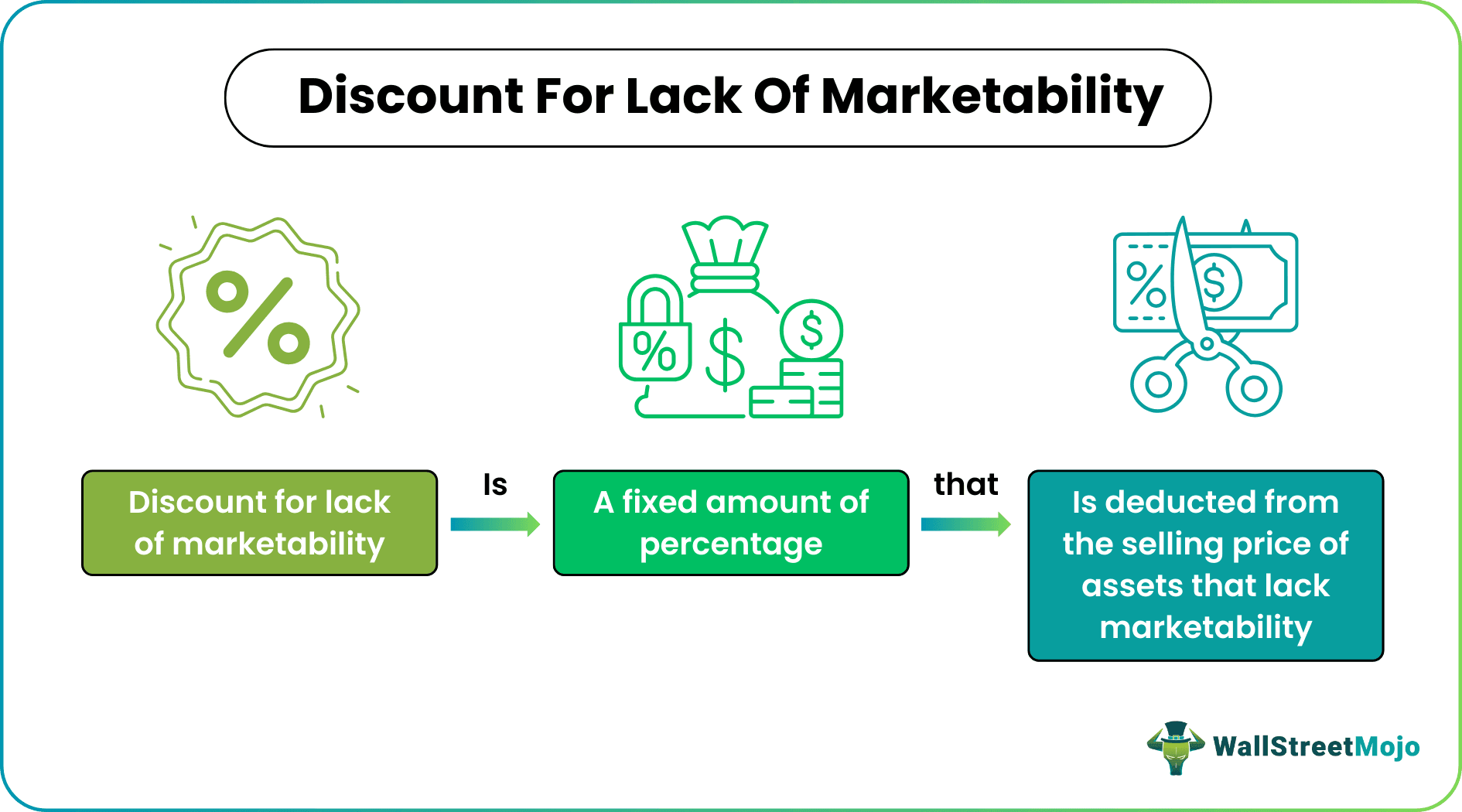Table Of Contents
What Is Discount For Lack Of Marketability (DLOM)?
Discount for Lack of Marketability (DLOM) is the fixed or percentage reduction in an asset or investment value due to its limited marketability or liquidity. It is a financial concept that helps account for the difficulty in selling or transferring an asset that is not easily traded in the open market.

Certain assets, like privately-held stocks, restricted securities, and non-tradable investments, may face limitations in finding buyers or require a longer time to sell. This lack of marketability risks potential investors or buyers, as they may not be able to convert the asset into cash quickly. A discount is applied to the asset's value to compensate for this risk.
Key Takeaways
- Discount for Lack of Marketability (DLOM) is a financial concept that measures an investment or asset's value reduction because of its limited liquidity or marketability.
- Some assets may take longer to sell or find it difficult to get potential buyers or investors. The DLOM is applicable for such investments.
- The estimation is subjective and may vary according to market conditions and the evaluator's perception.
Discount For Lack Of Marketability Explained
Discount for Lack of Marketability is a financial concept that aids in accounting for the reduced value of an asset or investment due to its limited marketability or liquidity. Assets not easily traded in the open market may require more time, effort, and expense to sell. The DLOM is applicable for valuing assets that face restrictions on their transferability or are not publicly traded.
These assets tend to have a more limited buyer pool, and finding a willing buyer may take longer than publicly traded investments. A discount is applied to their value to compensate for the increased risk and effort of selling such assets. The DLOM represents the percentage reduction in price or value that reflects the lack of marketability. This calculation is subjective and can differ based on the specific circumstances and the investor or estimator's judgment.
Calculation Methods
The methods to calculate DLOM are:
#1 - Option Pricing Methods
These mathematical models help estimate the DLOM by applying principles from options pricing theory. These models calculate the value of an investment by considering factors like time to marketability, volatility, risk-free rate, and other relevant variables. One standard option pricing model is the Black Scholes model, developed for valuing publicly traded options.
The inputs to the model include the expected holding period, the underlying asset's volatility, risk-free interest rate, and other investment factors. Option pricing models offer a quantitative approach for estimating the DLOM by incorporating market dynamics and the time value of money. However, accurate inputs and assumptions are crucial for reliable results.
#2 - IPO Method
This method assists in estimating the DLOM by analyzing the price difference between shares sold in private transactions before an initial public offering (IPO) and the subsequent IPO price. This method assumes that the price difference reflects the market's idea of the lack of marketability associated with the pre-IPO shares.
Evaluators examine data from private transactions involving the company's shares before they went public. They compare the prices paid for those shares with the price they were eventually offered to the public in the IPO. The difference in prices is used to estimate the DLOM.
#3 - Restricted Stock Method
It is a standard method estimators employ for calculating the DLOM. This method compares the prices of publicly traded shares to the restricted shares in the same company. The perception is that the price difference between freely tradable and restricted shares reflects the discount associated with the lack of marketability. This method is widely used due to the data availability from transactions involving restricted securities. Moreover, comparing the prices between restricted and freely tradable shares is comparatively easier.
Examples
Let us understand DLOM with the following examples:
Example #1
Suppose Annexe Ltd. is a private company owned by three individuals. John, a minority interest, wants to sell his ownership interests to another private buyer. However, since the process lacks liquidity, DLOM will be applied here. The evaluator estimated the DLOM to be 25%. Thus, the value of John's ownership interest would reduce accordingly. His ownership interest is valued at $50,000. After applying the DLOM, the discounted value would be $50,000 - 25% * $50,000, which is $37,500.
Example #2
On 15 September 2021, the FASB suggested potential improvements to the fair value guidance for equity securities associated with DLOMs. This particular proposal and feedback request is related to the effect of contractual limitations on the fair value of equity security. It works on removing the discounts based on contractual restrictions from the unit of account. The FASB clearly stated that contractual restrictions on the sale of public securities are not part of the unit. This is a discount for lack of marketability example.
Challenges
Some challenges to DLOM are as follows:
- The DLOM estimation process involves professional judgment and can be subjective. Different evaluators may arrive at various discount rates based on their interpretation of the data and techniques used.
- Obtaining accurate and reliable data for valuing assets can be challenging. Limited transaction data and market information may result in inaccurate DLOM estimates.
- There is no universally accepted method for calculating DLOM. Different approaches and models may yield different results, resulting in discrepancies in the estimations.
- Several factors influence DLOM, including time to marketability, restrictions on transferability, market conditions, and investor demand. Assessing and quantifying these factors accurately can be a complex procedure.
- Valuing the assets and applying DLOM may have legal and regulatory implications. Compliance with relevant laws, regulations, and standards complicates the analysis.
- The ongoing market conditions can impact the asset's liquidity and marketability. Market volatility, economic fluctuations, industry trends, and shifts in market sentiment can influence the DLOM. As a result, the estimation may require regular reassessment.
Discount For Lack Of Marketability vs Discount For Lack Of Control
The differences between the two are:
- Discount for Lack of Marketability: It is a reduction in an asset or investment value owing to its limited marketability or liquidity. It accounts for the difficulty in selling or transferring an asset that is not easily traded in the open market. DLOM is usually applied to privately-held assets, restricted securities, and non-tradable investments. The discount reflects the potential risk and costs of selling the asset and compensates the buyer for the lack of immediate liquidity.
- Discount for Lack of Control: Discount for Lack of Control (DLOC) is a reduction in an ownership interest value in a company due to the absence of control over decision-making. It addresses that a minority interest may have limited influence on the company's operations, strategic decisions, and dividend distributions. DLOC applies when a controlling interest exists, like when a majority shareholder has the power to control the company's affairs. The discount reflects the market's perception that a minority interest cannot influence or direct the company's activities.

